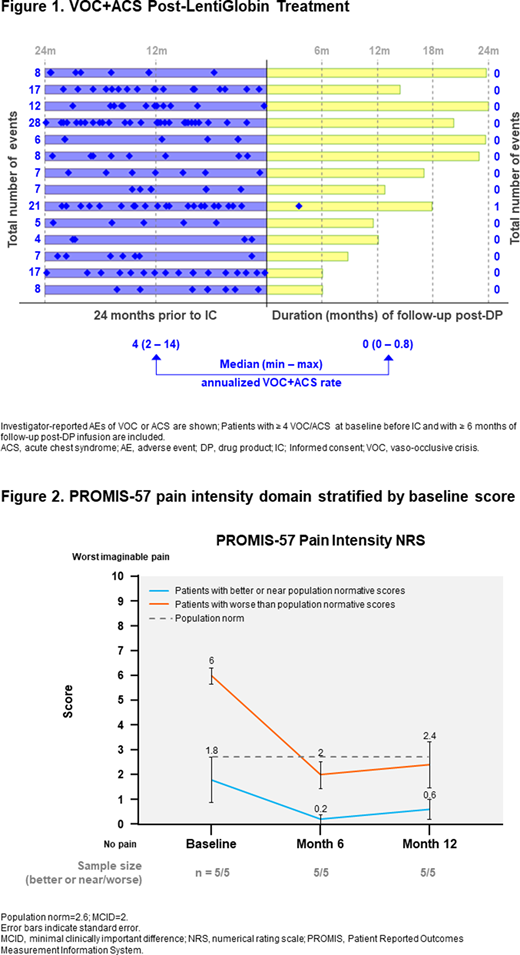Background
Sickle cell disease (SCD) is caused by abnormal sickle hemoglobin (HbS) and results in chronic hemolytic anemia, painful vaso-occlusive events (VOEs), and progressive vasculopathy that lead to significant morbidity. While acute vaso-occlusive pain is a defining clinical feature, chronic daily pain also contributes significantly to poor quality of life in many adult patients.
The ongoing Phase 1/2 HGB-206 Study (NCT02140554) evaluating safety and efficacy of LentiGlobin for SCD (bb1111) gene therapy (GT) uses a modified human β-globin gene that produces GT-derived anti-sickling hemoglobin (HbAT87Q). Data from Group C patients including red blood cell (RBC) physiology, clinical outcomes, and patient-reported pain intensity are presented here.
Methods
Patients (≥12 and ≤50 years) with SCD and stroke or severe VOEs, including acute episodes of pain and acute chest syndrome (ACS), were enrolled. CD34+ cells collected by plerixafor mobilization/apheresis were transduced with BB305 lentiviral vector. LentiGlobin was infused following myeloablative busulfan conditioning. Patients were monitored for laboratory evaluations including Hb levels and hemolysis markers, SCD-related outcomes, pain intensity using the Patient Reported Outcomes Measurement Information System (PROMIS)-57, and adverse events (AEs). Data are median (min-max) unless otherwise stated.
Results
As of 3 March 2020, 40 Group C patients (23.5 [12-38] years) initiated cell collection; 25/40 were treated with LentiGlobin and followed for 12.1 (2.8-24.8) months. Neutrophil and platelet engraftment were achieved at 19 (12-27) days and 28 (19-136) days, respectively.
All patients stopped RBC transfusions by 90 days post-treatment. In 16 evaluable patients with ≥6 months of follow-up, total Hb at last visit was 11.5 (9.6-16.2) g/dL, with HbAT87Q contribution of 5.2 (2.7-9.4) g/dL, HbS of 6.1 (4.9-7.8) g/dL, and median HbS ≤ 60% of total Hb. Exploratory assays showed near pancellular expression of HbAT87Q ≥6 months post-treatment (N=9 patients), with ~90% of RBCs containing βA-T87Q by 18 months, and reduction in sickling propensity comparable to sickle cell trait. At last visit post-treatment, key hemolysis markers were trending towards normalization with median (quartile [Q]1-Q3) lactate dehydrogenase of 212 (201-287) U/L, reticulocyte count of 178 (146.5-236.3) ×109/L, and total bilirubin of 19 (15.4-27.4) µmol/L (all for n=25).
In 14 patients with ≥6 months of follow-up and history of vaso-occlusive crisis (VOC) or ACS, the annualized VOC+ACS rate was 4.0 (2.0-14.0) in the 2 years prior to treatment. Post-treatment, no ACS or serious VOCs were observed in these patients. One non-serious Grade 2 VOC occurred ~3.5 months after LentiGlobin infusion, resulting in a 99.5% (95% confidence interval, 92.4%-100%) mean reduction in the annualized VOC+ACS rate post-treatment (Figure 1).
Patients with PROMIS-57 pain intensity scores "worse" than the population norm at baseline reported clinically meaningful improvements in pain reduction at 12 months post-treatment (n=5). Patients with scores near or "better" than the population norm at baseline (n=5) remained stable over time (Figure 2).
The most common non-hematologic Grade ≥3 AEs post-treatment were stomatitis (n=15) and febrile neutropenia (n=11). Serious AEs reported in ≥2 patients post-treatment were nausea, opioid withdrawal syndrome, and vomiting (all for n=2); 3 patients had LentiGlobin-related nonserious Grade ≤2 AEs. There has been one death, unlikely related to LentiGlobin, >18 months post-treatment in a patient with significant baseline SCD-related cardiopulmonary disease. There have been no events of graft failure, vector-mediated replication-competent lentivirus, or clonal dominance.
Summary
LentiGlobin for SCD GT results in near pancellular βA-T87Q expression and reduced HbS expression, which impacts the pathophysiology of SCD as demonstrated by reduced RBC sickling and hemolysis and increased total Hb. Complete resolution of VOC/ACS was observed in almost all patients, with 99.5% mean reduction in the annualized VOC+ACS rate post-treatment. In addition, patients overall reported an improved pain intensity score. The safety profile post-LentiGlobin remains generally consistent with myeloablative single-agent busulfan conditioning and underlying SCD. Longer follow-up and additional patients will be presented.
Thompson:CRISPR/Vertex: Research Funding; bluebird bio, Inc.: Consultancy, Research Funding; Novartis: Consultancy, Honoraria, Research Funding; Biomarin: Research Funding; Baxalta: Research Funding; BMS: Consultancy, Research Funding. Walters:AllCells, Inc: Consultancy; Veevo Biomedicine: Consultancy; Editas: Consultancy. Kwiatkowski:Agios: Consultancy; bluebird bio, Inc.: Consultancy, Research Funding; Apopharma: Research Funding; Novartis: Research Funding; Terumo Corp: Research Funding; Sangamo: Research Funding; Celgene: Consultancy; Imara: Consultancy; Bristol Myers Squibb: Consultancy. Aygun:Patient-Centered Outsomes Research Institute: Research Funding; National Heart, Lung, and Blood Institute: Research Funding; National Institute of Nursing Research: Research Funding; bluebird bio: Membership on an entity's Board of Directors or advisory committees, Research Funding. Schmidt:German Cancer Research Center, Heidelberg, Germany: Current Employment; GeneWerk GmbH, Heidelberg, Germany: Other: Equity ownership. DelCarpini:bluebird bio, Inc.: Current Employment, Other: Ownership Interest and Salary. Pierciey:bluebird bio, Inc.: Current Employment, Other: Ownership Interest and Salary. Miller:bluebird bio, Inc.: Current Employment, Other: Ownership Interest and Salary. Gallagher:bluebird bio, Inc.: Current Employment, Other: Ownership Interest and Salary. Chen:bluebird bio, Inc.: Consultancy. Goyal:bluebird bio, Inc.: Current Employment, Other: Ownership Interest and Salary. Kanter:Wells Fargo: Honoraria; Cowen: Honoraria; Jeffries: Honoraria; AGIOS: Membership on an entity's Board of Directors or advisory committees; Medscape: Honoraria; GLG: Honoraria; NHLBI Sickle Cell Advisory Board: Membership on an entity's Board of Directors or advisory committees; SCDAA Medical and Research Advisory Board: Membership on an entity's Board of Directors or advisory committees; BEAM: Membership on an entity's Board of Directors or advisory committees; Sanofi: Consultancy; bluebird bio, inc: Consultancy, Honoraria; Novartis: Consultancy; Guidepoint Global: Honoraria.
Author notes
Asterisk with author names denotes non-ASH members.


This feature is available to Subscribers Only
Sign In or Create an Account Close Modal